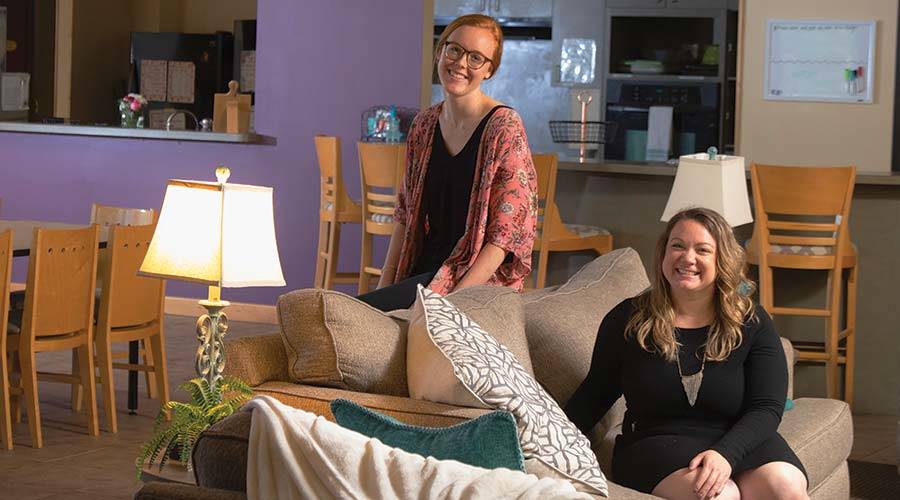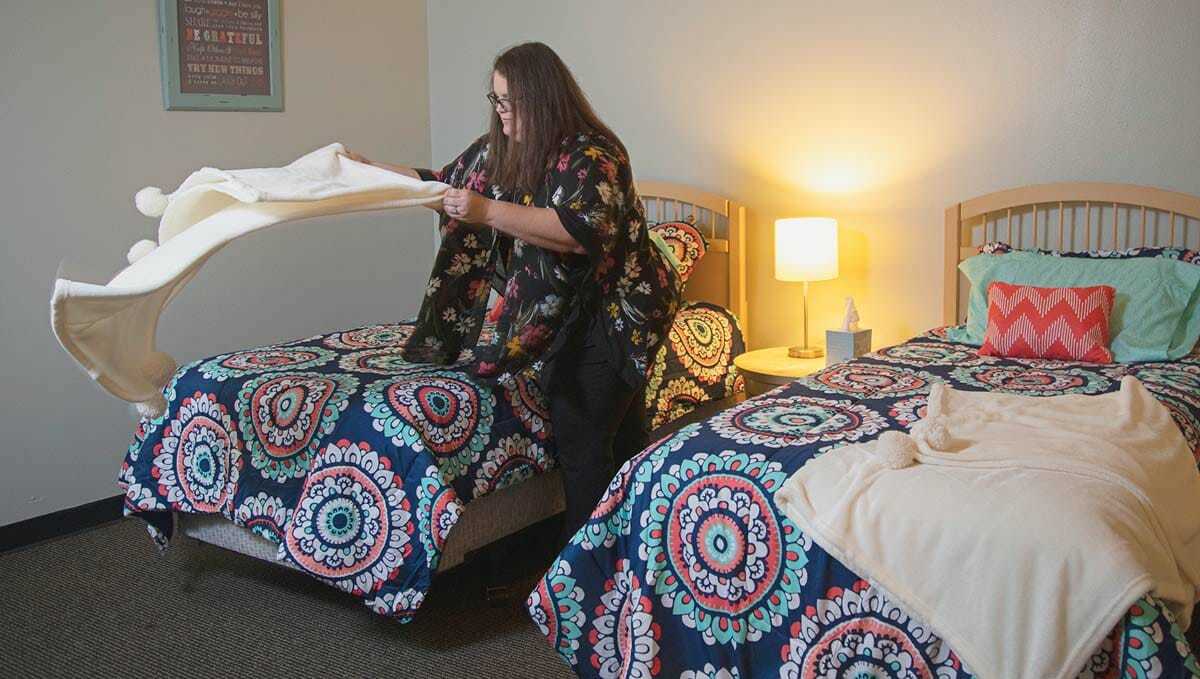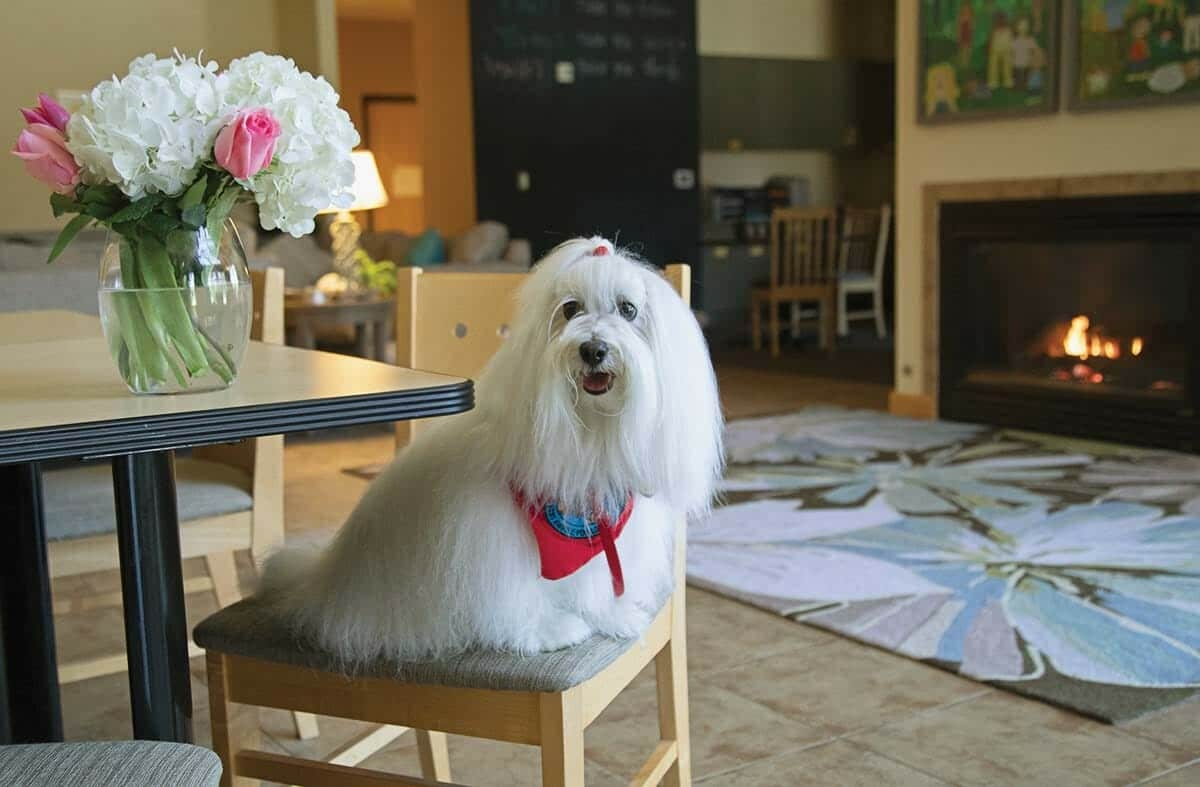
By Laura Samuel Meyn
Photos by Joyce Marshall
As they wait for adoption, girls in foster care now have a place to call their own at the Gladney Center.
Twin beds with medallion-print comforters in shades of pink and aqua are topped with coordinating chevron-pattern throw pillows, examples of cheerful touches found in 15 bedrooms — each with its own style and a private bathroom. Down the hall, a great room boasts large windows, a fireplace, a TV and comfy couches. There’s also a creative nook with craft supplies, a chalkboard wall and a piano. The pantry in the spacious kitchen is stocked with kid-friendly cereal including Honey Nut Cheerios. Opposite is a wall of windows overlooking a pool and, beyond that, a greenbelt where a resident owl makes frequent appearances.
Part of the Gladney Center for Adoption in southwest Fort Worth, the dormitory-style building was originally used to house birth mothers; Gladney operated a maternity home for some 70 years, with residents as young as 12. But in April, as a result of dramatically dwindling numbers of expectant mothers needing housing, the home was reimagined, updated and reopened for a more pressing 2019 need: housing girls in the foster care system.
The shift came as attitudes toward teenage pregnancy relaxed; the vast majority of Gladney birth mothers now choose to remain at home during their pregnancy, where they can stay in school or on the job and close to their network of family and friends while still being served by the center. With the departure of the last birth mother, the Gladney board met to discuss alternate uses for the facility.
“We eventually just asked the question, ‘Where is the greatest need?’ ” says Gladney president and CEO Mark Melson. “CPS [Child Protective Services] said it was preteen and teen girls. And that was perfect — we have experience in that environment.”
After visiting similar group homes and gathering information, advice and support, the center launched the program for girls ages 11 to 17 in April in conjunction with Our Community Our Kids, which handles local foster placement.
Because Gladney is an adoption agency (of the 248 children it placed with adoptive families last year, 90 were from state foster care), it has opted to house girls with basic to moderate care needs whose families have given up parental rights. “Not only are they available, they’re actively seeking adoption,” says Gladney vice president of communications Jennifer Lanter. “Our focus is on permanency through adoption.”
Melson says that on average only 22 to 23 percent of teenagers legally available for adoption will ever be adopted. “Our goal is 66 percent,” he says. “If a child has been removed from home, things have gone wrong. Our goal is to help her overcome the trauma she has gone through and get her prepared for adoption.”
It’s an important focus, because those who age out of the foster care system without being adopted face sobering statistics — higher rates of incarceration, mental illness and homelessness; for girls, the teen birth rate is doubled, and for boys, nearly a third will have served time in jail by the time they’re 19. “Statistics show it just takes one person to care about them, walk with them,” says Lanter. “If a child is in serial foster care — the average foster placement is 2½ to 3 years — there are usually no attachments.”
In the new group residence at Gladney, the focus is on normalcy: going to school, participating in extracurricular activities, doing chores at the home and even communing with four-legged friends when a few trusted therapy dogs visit. Three residential coordinators provide parenting as needed: lending a sympathetic ear, preparing meals or helping with homework. A caseworker manages the girls’ appointments and looks for adoptive families that would be a good match.
The home is funded in part by the state — to help cover some of the daily costs and assistance with adoption — and also by philanthropy. The maternity home costs were both by adoption fees and donations.
Melson plans to draw from community volunteers to enrich the lives of the girls awaiting adoption — possibilities include on-site cooking classes, yoga classes and exercise classes in the pool. Help with driving is always needed. And donations of computers, clothing and sports equipment are, too.
“Anything you think a child would enjoy, that’s what they need, and I guarantee they don’t have it,” says Melson. “We don’t want to have to say no; they’ve already been let down by everyone my size and up.”
Melson, himself the father of a child adopted out of the foster system at age 6, knows personally the transformative power a permanent home has in the life of a child. His son, in his first couple of weeks at home, consumed an apple, core and all, because he’d never been shown how to eat one. And while he had never been to a baseball game, he expressed a desire to learn the sport, which Melson was happy to oblige.
“As a child with severe ADHD, and the trauma he’d gone through, it’s been impressive to see how well he can focus; he has a good arm, too,” says Melson. “He didn’t know how to ride a bike or swim, but he learned fast. Boy, they can catch up so quickly with love and care.”
Families that adopt preteens or teens tend to be more established than those adopting babies; they include empty nesters and couples who’ve experienced infertility, among others. “Adopting an older child is going to take a parent who has a lot of patience,” says Melson. “It’s a village that helps to raise that child. Family, neighbors and friends step in and provide love and support when they need to.”
Gladney offers ongoing parent support groups and training, and families adopting out of the foster care system are eligible for everything from health care for their child to public university tuition waivers.
While closing the maternity home is the end of an era, Melson points out that it’s also a return to Gladney’s roots, as the 132-year-old institution began by taking in orphans and working toward their placement with an adoptive family.
“I think Gladney has done an incredible job. It has always had a child and family focus since Day One. But I think there’s more we can do; this is the first step into that arena, to leverage the family network, name and supporters we have to make a tremendous impact,” he says. “I’m hoping we can build a model that can make an impact in permanency and adoption and replicate that throughout Texas and the U.S.”
THE DETAILS
Gladney Center for Adoption To volunteer or donate to the new residential group home at Gladney, contact Mary Ownbey at 817-922-6035 or Jennifer Lanter at 817-922-5968. To learn more about adopting through the foster care system and classes for prospective parents, call 817-922-6000 or visit adoptionsbygladney.com.




